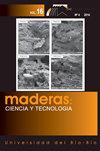Wettability and decay of particleboards manufactured with thermally treated sugarcane residue and bamboo (Dendrocalamus asper) particles
IF 1.5
4区 农林科学
Q3 MATERIALS SCIENCE, PAPER & WOOD
引用次数: 0
Abstract
This study aimed to evaluate the chemical composition of wood particles (control and treated), and the effects of thermal modification and adhesive levels on the wettability and biological resistance of particleboards made of sugarcane residue and bamboo (Dendrocalamus asper). Therefore, 75% bamboo particles and 25% sugarcane residue (bagasse) were used for producing the particleboards. The particles were treated at 220 °C for 3h35min. Urea formaldehyde (UF) adhesive was used in three solid contents (10%, 12% and 14%) based on the dry mass of the particles. The mat was cold pre-consolidated (pressure of 0,5 MPa for 5 min) and after hot consolidated (3,45 MPa, 180 oC, 10 min). Water and ethylene glycol and two measurement times were used to measure the contact angle. Gloeophyllum trabeum and Rhodonia placenta (brown rot) and Trametes versicolor (white rot) fungi were used for the biological resistance test. There was a change in the chemical composition of the treated particles such as a reduction in the levels of lignin (bagasse and bamboo), total extracts and holocellulose (bagasse). The thermal treatment increased the final contact angles obtained with water. The particleboard surfaces were classified as non-wettable and partially wettable to the tested solvents. The thermal treatment provided biological resistance improvements in the particleboards to the tested fungi, being classified as very resistant to Rhodonia placenta, resistant to very resistant to Gloeophyllum trabeum, and moderate to resistant to Trametes versicolor.用热处理过的甘蔗渣和竹颗粒制造的刨花板的润湿性和腐烂性
本研究旨在评价木材颗粒(对照和处理)的化学成分,以及热改性和胶粘剂水平对甘蔗渣和竹材刨花板润湿性和生物抗性的影响。因此,75%的竹颗粒和25%的甘蔗渣(甘蔗渣)用于生产刨花板。在220℃下处理3h35min。脲醛(UF)粘合剂根据颗粒的干质量分为三种固含量(10%、12%和14%)。毡片进行冷预固结(压力0.5 MPa, 5 min)和热固结(压力3.45 MPa, 180℃,10 min)。用水和乙二醇进行接触角的测量,测量时间为2次。以黄球菌(Gloeophyllum trabeum)、褐腐菌(Rhodonia胎盘)和白腐菌(Trametes versicolor)进行生物抗性试验。处理过的颗粒的化学成分发生了变化,例如木质素(甘蔗渣和竹子)、总提取物和全息纤维素(甘蔗渣)的含量降低。热处理增加了与水的最终接触角。刨花板表面被分为不可湿性和部分可湿性。热处理后的刨花板对被试真菌的生物抗性得到了改善,对胎盘Rhodonia非常耐,对Gloeophyllum trabeum非常耐,对花斑曲霉菌(Trametes versicolor)中度耐。
本文章由计算机程序翻译,如有差异,请以英文原文为准。
求助全文
约1分钟内获得全文
求助全文
来源期刊

Maderas-ciencia Y Tecnologia
工程技术-材料科学:纸与木材
CiteScore
2.60
自引率
13.30%
发文量
33
审稿时长
>12 weeks
期刊介绍:
Maderas-Cienc Tecnol publishes inedits and original research articles in Spanish and English. The contributions for their publication should be unpublished and the journal is reserved all the rights of reproduction of the content of the same ones. All the articles are subjected to evaluation to the Publishing Committee or external consultants. At least two reviewers under double blind system. Previous acceptance of the Publishing Committee, summaries of thesis of Magíster and Doctorate are also published, technical opinions, revision of books and reports of congresses, related with the Science and the Technology of the Wood. The journal have not articles processing and submission charges.
 求助内容:
求助内容: 应助结果提醒方式:
应助结果提醒方式:


